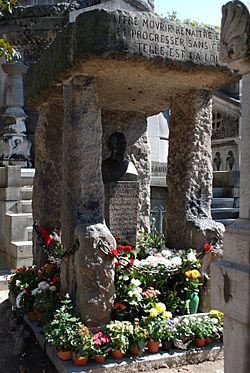Allan Kardec facts for kids
Quick facts for kids
Allan Kardec
|
|
|---|---|
 |
|
| Born |
Hippolyte Léon Denizard Rivail
3 October 1804 |
| Died | 31 March 1869 (aged 64) |
| Burial place | Père Lachaise Cemetery |
| Occupation | educator |
| Known for | Systematizer of Spiritism |
| Spouse(s) | Amélie Gabrielle Boudet (married 1832) |
| Signature | |
Allan Kardec was the pen name of a French teacher, writer, and translator named Hippolyte Léon Denizard Rivail. He was born on October 3, 1804, and passed away on March 31, 1869. He is famous for writing five important books that form the basis of a philosophy called Spiritism. He is also known as the founder of Spiritism.
Contents
Early Life and Education
Hippolyte Rivail was born in Lyon, France, in 1804. He grew up in a Catholic family. From a young age, he was very interested in philosophy and science. He studied with a famous educator named Johann Heinrich Pestalozzi.
Rivail earned degrees in science and even a doctorate in medicine. He was very smart and could speak many languages, including German, English, Italian, and Spanish, besides his native French. He was a member of several important groups that focused on history and science. He also taught free classes to help people who couldn't afford an education.
His work with Pestalozzi helped create new ways of teaching in schools in France and Germany. For many years, he worked as a teacher and writer, helping to improve education.
Family Life and New Interests
On February 6, 1832, Hippolyte Rivail married Amélie Gabrielle Boudet.
Later in his life, around 1855, Rivail met a man who introduced him to séances. These were popular gatherings where people tried to communicate with spirits. At these sessions, objects would sometimes move or make tapping sounds, which people believed were messages from spirits.
Rivail was curious but also very careful. He wanted to understand if these events were real or just tricks.
Exploring Spiritism
When he was in his early 50s, Rivail became very interested in these strange events. He saw objects moving and heard tapping sounds that seemed to be controlled by something unseen. He thought that these might be a new way for spirits to communicate.
Rivail decided to investigate these events scientifically. He believed it was important to first check if normal reasons could explain what was happening. He thought that some events might be tricks, hallucinations, or even just unconscious thoughts.
He wrote down over a thousand questions about spirits, how they communicate, and why humans live on Earth. He asked these questions to ten different mediums (people who claimed to communicate with spirits). He made sure the mediums didn't know each other.
From their answers, he noticed that many of the responses were similar. He concluded that the best explanation was that the spirits of people who had passed away were indeed communicating. He was convinced because the mediums:
- Gave correct information that they or others present didn't know.
- Showed skills they hadn't learned, like writing in a language they didn't know.
- Accurately showed the personalities of people who had died.
He gathered all the consistent answers and used them to create a new philosophy he called Spiritism. He first described it as "a science that deals with the nature, origin, and destiny of spirits, and their relation with the corporeal world."
Rivail started writing under the name "Allan Kardec." He published his first book on Spiritism, The Spirits' Book, on April 18, 1857. This book contained many questions and answers about spirits, the spirit world, and how it connects with our world.
After this, he wrote several other important books, including The Medium's Book, The Gospel According to Spiritism, Heaven and Hell, and The Genesis According to Spiritism. He also started a magazine called Revue Spirite. Together, these books are known as the Spiritist Codification.
Memorial

Allan Kardec passed away on March 31, 1869, due to an aneurysm. He was buried in the famous Cimetière du Père Lachaise in Paris.
Writings
- Cours pratique et théorique d’arithmétique (1824)
- Plan proposé pour l’amélioration de l’éducation publique (1828)
- Catéchisme grammatical de la langue française (1848)
- Le Livre des Esprits (The Spirits Book), 1857
- Le Livre des Médiums ('The Book on Mediums), 1861
- L’Évangile selon le Spiritisme (The Gospel According to Spiritism), 1864
- Le Ciel et L’Enfer (Heaven and Hell), 1865
- La Genèse (The Genesis According to Spiritism), 1868
See also
 In Spanish: Allan Kardec para niños
In Spanish: Allan Kardec para niños

